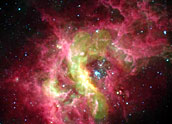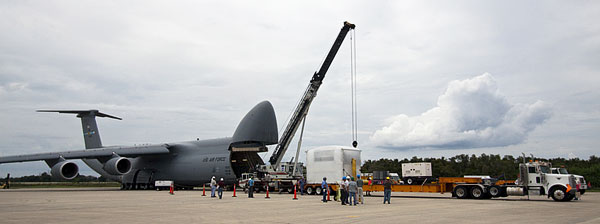
A cosmic ray detector designed to search for antimatter made its way to the Kennedy Space Center Friday in preparation for a February launch that will take it to the International Space Station on the final space shuttle flight.

The detector, called the “Alpha Magnetic Spectrometer” (AMS), was flown in from the CERN Labs in Switzerland. CERN is the European Organization for Nuclear Research.
“All but two of the scientists who collaborated on AMS are located at CERN,” NASA project manager Trent Martin, who oversees the AMS project, told TechNewsWorld. “They assembled AMS there and it was flown to Kennedy Space Center in Florida today.”
What Will the AMS Do?
The AMS detector was constructed and tested by an international team at CERN, which will also operate the device. The team consists of more than 600 physicists from 16 countries. They are organized under the sponsorship of the United States Department of Energy.
The AMS will be flown to the International Space Station (ISS) on board NASA’s final planned shuttle flight, which is currently slated for Feb. 26, 2011.
Once installed about the ISS, the 15,000-pound AMS will look for antimatter and dark matter while it orbits 200 miles above Earth. It will also collect information from cosmic particles.
How the AMS Detector Works
The AMS detector has five types of detectors and a large magnet that will produce a strong, uniform magnetic field of about 0.14 Tesla over an area of about one cubic meter. It also has two star detectors and a GPS system.
The detectors are a Transition Radiation Detector, which will measure particles zipping along at close to the speed of light; a Time of Flight detector, which will measure passing particles’ charge and velocity; an Electromagnetic Calorimeter, which will measure the energy and coordinates of electrons, positrons and gamma rays; and a Silicon Tracker will measure the coordinates of charged particles in the magnetic field.
The fifth detector is the Ring Image Cerenkov Counter. This will measure both velocity and charge of high-speed particles.
Cerenkov, or Cherenkov radiation, is electromagnetic radiation emitted when a charged particle such as an electron passes through an insulator faster than light can pass through that insulator. The particulars polarize the molecules of that insulator and, as the molecules resume their original state, they glow. The characteristic blue glow of nuclear reactors is due to Cerenkov radiation.
The AMS’s magnetic field will bend the paths of charged cosmic particles as they pass through its detectors.
AMS in Space
The AMS was initially scheduled for launch this year, but is now scheduled to be put in orbit next February.
This is because project members decided to swap out the cryogenically cooled magnet for a permanent magnet in hopes of extending the life of the experiment, which has reportedly cost US$2 billion.
“We switched to the permanent magnet because cryogen is consumable and will run out,” NASA’s Martin explained. “The AMS was originally scheduled to be in orbit for three years and we now hope to get that up to 10 years.”
The experiment is led by Nobel laureate Samuel Ting of the Massachusetts Institute of Technology. Ting first proposed building a large cosmic ray detector in 1994.
Matter in the Dark
The AMS device’s missions include locating dark matter and antimatter.
Dark matter is matter is undetectable by emitted or scattered electromagnetic radiation, but that scientists hypothesize exists from the effects of gravitation on visible matter and from background radiation. Fritz Swicky first postulated the concept of dark matter in 1934 to account for the evidence of missing mass in the orbital velocities of galaxies in clusters.
Other observations, such as the rotational speeds of galaxies, have indicated dark matter exists in the universe.
“In general terms, there’s evidence on both a large and small scale for dark matter,” Gillian Wilson, associate professor of cosmology at the University of California, Riverside, told TechNewsWorld. “We have evidence from weak gravitational lensing and from clusters of galaxies in very dense areas of the universe whizzing about much faster than one would expect,” she added.
A gravitational lens is formed when the light from a very distant, bright source such as a quasar is bent around a massive object such as a cluster of galaxies that lies between it and the observer. Most such bends occur as weak gravitational lensing, where the deflection of light from the source is so slight that it can only be detected by measurements from several sources around the massive object.
Nevertheless, it’s believed that there’s lots of dark matter in the universe.
“At this point, scientists believe that as much as 95 percent of what’s out there could be dark matter or dark energy, and we need to have an understanding of what it is,” NASA’s Martin pointed out. Dark energy and dark matter are, strictly speaking, not quite the same thing, but “I’m an engineer and I’ll leave that to the scientists to discuss,” Martin said.
Antimatter, Sci-Fi and the Big Whiz-Bang
The AMS is also searching for evidence of antimatter, which has long been the subject of science fiction.
“We know where the matter is, the question is, where’s the antimatter?” NASA’s Martin said. “The AMS will probe to see if we can find it.”
Finding it could be interesting, given that matter and antimatter have equal and opposite characteristics, so they obliterate each other when they come into contact. Scientists succeeded in creating small amounts of antimatter back in 2002, The New York Times reported. The antihydrogen atoms they created gave off the expected explosions when they came into contact with regular hydrogen atoms.
Science fiction writers have had a field day with antimatter for years. The sci-fi book Storm by A.E. Van Vogt postulates that gas clouds of matter and antimatter collide in space, creating a huge storm, for instance. Then there’s the book Fireball, by P.C. W. Davies, which is about a shower of antimatter meteorites hitting earth and causing widespread devastation.
However, NASA apparently has picked up on another possibility outlined in sci-fi — that antimatter would make a great fuel for space travel.
“In the ‘Star Trek’ series, antimatter is used to power the spaceship’s engines, but, for some reason, they needed lithium crystals as well, and it was never clear to me why that was,” technology analyst and sci-fi fan Rob Enderle told TechNewsWorld.
If the AMS does discover antimatter, will it survive the discovery? And, if it does, what will NASA do? You can’t handle antimatter with tools or instruments made from regular matter, after all.
“We’ll leave that to the scientists,” NASA’s Martin said. “If we discover that antimatter exists, we’ll have proved one set of theories about the beginning of the universe.” [*Correction – Aug. 30, 2010]
“This search for antimatter and dark matter is the kind of thing that gets people excited about our potential future,” he added. “It could, of course, also lead to the end of the world.”
*ECT News Network editor’s note – Aug. 30, 2010: The original published version of this article misquoted NASA’s Trent Martin as saying, “we’ll have proved one set of theories about the beginning of the world.” Martin actually said, “we’ll have proved one set of theories about the beginning of the universe.” We regret the error.






















































Update Concepts: Electron, Matter/Antimatter
Electron: The Present Universe Runs ONLY Forward
A. From "Sizing up the Electron"
Measuring the inner shape of the famous particle could help solve a cosmic mystery
http://www.sciencenews.org/view/feature/id/69229/title/Sizing_up_the_Electron
– "Physicists suspect that electric dipole moments exist because they allow particles to violate what’s known as time-reversal symmetry. Although symmetry sounds like a good thing, scientists know that processes involving other particles (such as B mesons) behave differently whether running forward or backward, a violation of time-reversal symmetry. In order for this to happen, the electron (and other fundamental particles) must have an internal structure, something an electric dipole moment can reveal."
– "The Big Bang should have created matter and antimatter in equal AM ounts".
B. The Universe is SPACEDISTANCE, NOT SPACETIME. It runs ONLY FORWARD.
From "Commonsensical Cosmic Rebirth", comment on "Cosmic reincarnation idea may be dead"
http://www.sciencenews.org/index/generic/activity/view/id/67788/title/Cosmic_reincarnation_idea_may_be_dead
"Rethink
– A Basic Physics Tenet: SpaceDistance, in lieu of SpaceTime.
– The universe in which we live: It is a dualistic, mass-energy, cyclic array."
The universe evolves. No forward and backward. Only forward, only m (including life) being reconverted into energy.
See "A Simpler Origin for Life", comment.
http://www.scientificamerican.com/article.cfm?id=simpler-origin-for-life
"Complexity in life is what physics calls Broken Symmetry, which is what biology calls Evolution."
C. The Big Bang was the start of the still ongoing D>0, of the still growing D
in E=Total[m(1 + D)]
The Big Bang did not create matter or antimatter, in any AM ount. It was the start of the still ongoing reconversion of m into E. It was the culmination of the 10^-35 seconds long singularity. Matter and antimatter are products of evolution of mass along its route of reconversion into energy, started at Big Bang.
Dov Henis
(Comments From The 22nd Century)
Dispel Some Figments Of 2010 Science Imagination
http://pulse.yahoo.com/_2SF3CJJM5OU6T27OC4MFQSDYEU/blog/articles/245540
03.2010 Updated Life Manifest
http://www.the-scientist.com/community/posts/list/54.page#5065
28Dec09 Updated "Implications Of E=Total[m(1 + D)] "
http://www.the-scientist.com/community/posts/list/180/122.page#3108
Cosmic Evolution Simplified
http://www.the-scientist.com/community/posts/list/240/122.page#4427
"Gravity Is The Monotheism Of The Cosmos"
http://www.the-scientist.com/community/posts/list/260/122.page#4887
Evolution, Natural Selection, Derive From Cosmic Expansion
http://darwiniana.com/2010/09/05/the-question-reductionists-fear/